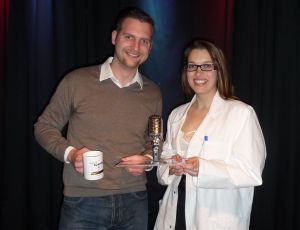Conveying science in an entertaining way to the broad public: This is the mission of the Science Slam. Björn Waterkotte and Dorothea Helmer from the KIT Institute of Organic Chemistry communicated best to the audience: Both PhD students working in the group headed by Dr. Katja Schmitz convinced the audience at the sold-out Jubez in Karlsruhe with their presenta-tion “How to Make Proteins Happy.” They were given 95 of 100 possible points by the audience jury and won the competition.
Waterkotte and Helmer won the competititon on March 3, 2011 together with Tobias Pfaff from ETH Zurich, who presented the “Physics of Animated Films.” The three winners were awarded the challenge cup and an annual subscription of the journal “Geo.” In total, six participants took part and reported about their projects - from bachelor and PhD theses to scientific work - in a presentation of 10 minutes: Understandably, inventively, and entertainingly. The presentations focused on topics relating to informatics, sociology, chemistry, and materials sciences.
What the audience learned about happy proteins: They have a three-dimensional structure and interact with specific binding partners. This is of particular interest to biotechnology and the development of medical substances. For the corresponding investigations, the proteins have to be attached to surfaces such that they can bind to their partner. Björn Waterkotte, whose PhD thesis focuses on this topic, intends to reach an optimum orientation of the proteins via the properties of the surface and the surrounding medium. This may sound abstract, but it was explained vividly by his PhD colleague, Dorothea Helmer: She played her role as a protein and “specifically” selected the high-heels from all shoes brought along as “binding sites.” The attractive “surrounding medium” was a date with the actor George Clooney. This humorous presentation of molecular binding processes was given a big applause by the audience.
After competitions at Freiburg, Heidelberg, Frankfurt, Ulm, and Stuttgart, the Science Slam on March 3 took place in Karlsruhe for the first time. Other events will follow this year.
Further information: www.scienceslam.de
In close partnership with society, KIT develops solutions for urgent challenges – from climate change, energy transition and sustainable use of natural resources to artificial intelligence, sovereignty and an aging population. As The University in the Helmholtz Association, KIT unites scientific excellence from insight to application-driven research under one roof – and is thus in a unique position to drive this transformation. As a University of Excellence, KIT offers its more than 10,000 employees and 22,800 students outstanding opportunities to shape a sustainable and resilient future. KIT – Science for Impact.

